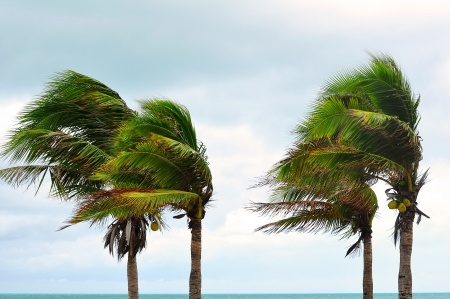Growing up near the lush green tropical forests of India, I’ve always had a fascination for people’s ability to use their surrounding ecosystem in beneficial ways. In academia, we call it as Ecosystem Services, i.e., an essential service that an ecosystem can offer to communities.
There are a number of examples where humans have utilized ecosystem services to their advantage. One such is the cyclone impact mitigation service that the ancient tree of Palmyra offers.
Palmyra, commonly known as Palm trees, are quite well spread across the globe. They can even be found in California and South-Eastern states of the U.S. In fact, 14 species of palms are native to the U.S.
Palmyra: The Survivor of Storms
Depending on the species, their height and other characteristics vary. Many species of Palm trees are highly resilient to cyclonic winds and are known to come out unscathed.
During Hurricane Irma, many Palm trees survived the wind onslaught and remained unaffected. The same is true in other parts of the world as well.
But how do they do this? A large number of short roots at the base gives it a stronger anchor and a special stem provides bending flexibility of almost 50 degrees.
M. Narasimhan, the former head of the Department of Botany at the Madras Christian College of India, says “Three factors contribute to the survival of palmyra trees: First, the root system, though fibrous, has a strong grasping capacity. Second, the vascular system of the stem makes the tree flexible. Third, the crown of the tree. The folded leaves and structure help it withstand strong winds.”
Livelihood for the Poor and a Haven for Local Biodiversity
Palm trees were once abundant in the Southern India region. The Tamil Nadu Agricultural University, India’s finest, estimates that the state of Tamil Nadu alone accounts for more than 50% of all palm trees in India.
People and wildlife in this part of the world have been benefiting from palm trees for many centuries and it has a deep connection to the culture of the people. There is even an ancient literature from the region that describes how Palm trees and its parts can be used in 801 different ways.
The palm trees can also offer livelihood insurance, especially in a region which is predominantly dependent on coconut trees. Coconut trees do not withstand cyclones. A cyclone in 2018 destroyed 5 million coconut trees in the state of Tamil Nadu alone, impacting the livelihood of 70,000 farmers. But the same cyclone was not able to destroy Palm trees.
Besides being a natural cyclone barrier, Palm trees are highly resilient to droughts and known to survive through multiple droughts throughout their lifespan of 100 years or so. Palm trees also to recharge groundwater levels. This aspect can be significantly useful in parched and dry landscapes of tropical regions.
SS Davidson, an Environmental Educationist, says that the Palmyra trees have been an an important part of livelihood of people living in rural communities: “While comparing the palmyra with other trees of Tamil Nadu one can realize the Palmyra offers its produce to the people throughout the year. There is the sweet juice of its fruit. Palm fruit, palmyra root, jaggery (an alternative to white sugar) are known for their healthy nutrients.”
He also points out how they are critical to local biodiversity: “Palmyra trees provide the habitat for kites, parrots, peacocks, black ibis and Weaver birds. Peacocks sleep on palmyra trees at night while other birds even breed there. Some of the nocturnal birds can be seen resting on the palmyra in between their hunting trips.”
Sunbirds, Indian rollers, palm swifts, silver bills, white-breasted kingfishers and shikras have a special liking for the palm trees. Others note that tree shelters reptiles such as snakes and monitor lizards.
Realizing its immense socio-ecological benefits, Nonprofits in India have now initiated the planting of Palm trees along the banks of rivers in Southern India, with an intention to mitigate cyclone impact on the communities there and revive a source of livelihood.
Palm trees provide multiple benefits and tropical countries around the world may invest in planting specific species of Palm that are best suited to the local ecosystems.
